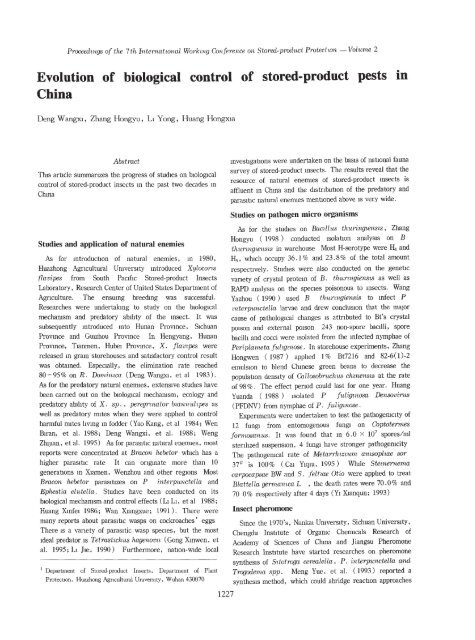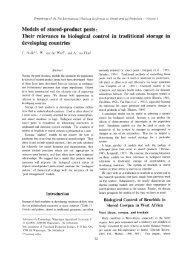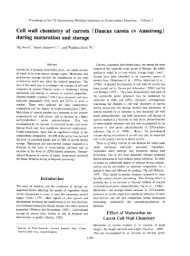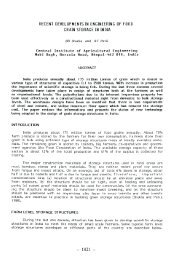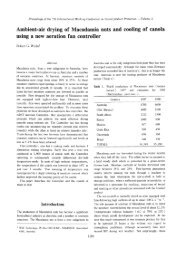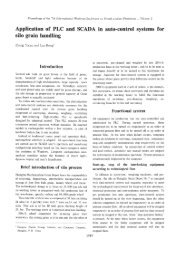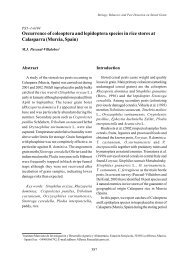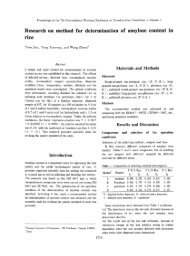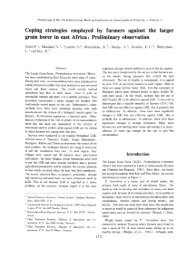Evolution of biological control of stored-product pests - SPIRU Index ...
Evolution of biological control of stored-product pests - SPIRU Index ...
Evolution of biological control of stored-product pests - SPIRU Index ...
You also want an ePaper? Increase the reach of your titles
YUMPU automatically turns print PDFs into web optimized ePapers that Google loves.
Proceedtngs <strong>of</strong> the 7th Internatwnal Worhng Conference on Stored-prodiu.ct Protectum. - Volurrw 2<br />
<strong>Evolution</strong> <strong>of</strong> <strong>biological</strong> <strong>control</strong> <strong>of</strong> <strong>stored</strong>-<strong>product</strong> <strong>pests</strong> in<br />
China<br />
Deng Wangxi , Zhang Hongyu, Lr Yong, Huang Hongxia<br />
Abstract<br />
ThIS article summanzes the progress <strong>of</strong> studies on <strong>biological</strong><br />
<strong>control</strong> <strong>of</strong> <strong>stored</strong>-<strong>product</strong> insects m the past two decades in<br />
Chma<br />
Studies and application <strong>of</strong> natural enemies<br />
As for mtroduction <strong>of</strong> natural enemies, in 1980,<br />
Huazhong Agncultural Umversity introduced Xylocm"tS<br />
flavipes from South Pacific Stored-<strong>product</strong> Insects<br />
Laboratory, Research Center <strong>of</strong> United States Department <strong>of</strong><br />
Agnculture. The ensumg breedmg was successful.<br />
Researches were undertakmg to study on the <strong>biological</strong><br />
mechamsm and predatory ability <strong>of</strong> the insect. It was<br />
subsequently mtroduced mto Hunan Province, SIchuan<br />
Provmce and Guizhou Provmce In Hengyang , Hunan<br />
Province, Tianmen, Hubei Province, X. fuunpes were<br />
released m gram storehouses and satisfactory <strong>control</strong> result<br />
was obtained. Especially, the elimination rate reached<br />
80 - 95% on R. Dominica (Deng Wangxi, et al 1983) .<br />
As for the predatory natural enerrues, extensive studies have<br />
been earned out on the <strong>biological</strong> mechamsm, ecology and<br />
predatory ability <strong>of</strong> X. sp., pereqruuitor bummulvpes as<br />
well as predatory mites when they were apphed to <strong>control</strong><br />
harmful mites hvmg m fodder (Yao Kang, et al 1984; Wen<br />
Biran, et al. 1988; Deng Wangxi, et al. 1988; Weng<br />
ZhiJIan, et al. 1995) As for parasItIc natural enemIes, most<br />
reports were concentrated at Bracon lwbetor whIch has a<br />
higher parasItIc rate It can ongma te more than 10<br />
generatIOns m Xlamen, Wenzhou and other regIOns Most<br />
Bracon lwbetor parasItIzes on P interpunctella and<br />
Eplwstia elutella. StudIes have been conducted on its<br />
bIOlogicalmechamsm and <strong>control</strong> effects (LI LI, et al 1988;<br />
Huang Xmfel 1986; Wan Xlangxue; 1991). There were<br />
many reports about parasItIc wasps on cockroaches' eggs<br />
There IS a vanety <strong>of</strong> parasItic wasp speCIes, but the most<br />
Ideal predator IS Tetrashchus hagenov/,l, (Gong Xmwen, et<br />
al. 1995; LI lIe, 1990) Furthermore, natIon-WIde local<br />
1 Department <strong>of</strong> Stored-<strong>product</strong> Insects, Department <strong>of</strong> Plant<br />
Protection, Huazhong Agncultural Urnversity, Wuhan 430070<br />
1227<br />
investigations were undertaken on the baSIS<strong>of</strong> national fauna<br />
survey <strong>of</strong> <strong>stored</strong>-<strong>product</strong> insects. The results reveal that the<br />
resource <strong>of</strong> natural enemies <strong>of</strong> <strong>stored</strong>-<strong>product</strong> msects is<br />
affluent in Chma and the distnbution <strong>of</strong> the predatory and<br />
parasitic natural enemies mentioned above ISvery wide.<br />
Studies on pathogen micro organisms<br />
As for the studies on Bacillus tnuruunensi«, Zhang<br />
Hongyu (1998) conducted isolation analysis on B<br />
tnuruunensu: in warehouse Most H-serotype were H4 and<br />
Hs, which occupy 36. 1% and 23.8 % <strong>of</strong> the total amount<br />
respectively. Studies were also conducted on the genetic<br />
vanety <strong>of</strong> crystal protem <strong>of</strong> B. thurinqiensis as well as<br />
RAPD analysis on the species poisonous to insects. Wang<br />
Yazhou (1990) used B thumsunensis to mfect P<br />
mierpunciellc: larvae and drew conclusion that the major<br />
cause <strong>of</strong> pathological changes IS attnbuted to Bt's crystal<br />
polson and external polson 243 non-spore bacilli, spore<br />
bacilh and cocci were Isolated from the mfected nymphae <strong>of</strong><br />
Periplameta fuLLgmose. In storehouse experiments, Zhang<br />
Hongwen (1987) applied 1% Bt7216 and 82-6(1)-2<br />
emulsion to blend Chmese green beans to decrease the<br />
population density <strong>of</strong> Callosobruchus chvneneu at the rate<br />
<strong>of</strong> 98%. The effect penod could last for one year. Huang<br />
Yuanda (1988) Isolated P fuligtnosa Densooirus<br />
(PFDNV) from nymphae <strong>of</strong> P. [ul unnose .<br />
Expenments were undertaken to test the pathogerucity <strong>of</strong><br />
12 fungi from entomogenous fungi on Coptotermes<br />
formosamus. It was found that m 6.0 x 10 7 spores/ml<br />
stenlIzed suspenSIon, 4 fungI have stronger pathogemcity<br />
The pathogemcal rate <strong>of</strong> Metarrhl,ztum anLSopltae SOl"<br />
37# is 100% (Cal Ylqm, 1995) WhIle Stetnerrwrna<br />
carpocapsae BW and S. feltme Otio were apphed to treat<br />
Blattella gernwnwa L ,the death rates were 70.0% and<br />
70 0% respectively after 4 days (YI Xlanqun; 1993)<br />
Insect pheromone<br />
Smce the 1970's, Nankat Umverslty, Sichuan UniversIty,<br />
Chengdu InstItute <strong>of</strong> Orgamc ChemIcals Research <strong>of</strong><br />
Academy <strong>of</strong> SCIences <strong>of</strong> Chma and liangsu Pheromone<br />
Research InstItute have started researches on pheromone<br />
synthesIs <strong>of</strong> Sttotroga cerealella, P. interpunctella and<br />
Trogodenw spp. Meng Yue, et al. (1993) reported a<br />
syntheSISmethod, which could abridge reactIon approaches
Proceedmqs <strong>of</strong> the 7th Iniernatumal Worhng Conference on Stored-<strong>product</strong> Protection - Voz'nme 2<br />
and Improve efficiency Aggregation pheromone was hence<br />
developed from Crytolestes [erruqineus and C pusillus .<br />
Pheromone from C ch.mensis , S. zeanuus and Steqoaucm<br />
ixuuceum was Isolated, collected and purified Biologtcal<br />
actrvation analysis was undertakent Wu Guixm, 1983; Huang<br />
Yuanda, 1985;Gu Zhonghuang, 1993)<br />
As for the studies and application <strong>of</strong> pheromone m <strong>stored</strong><strong>product</strong><br />
Lepidoptera insects, most reports were concerned<br />
about S cerealella and P. inierpunctella.. One<br />
apphcauon m storehouse can ehmrnate msects for a whole<br />
year. "Gossyplure ' <strong>of</strong> Pectmophora gossypieUa was used in<br />
storehouse to attract S. cerealella and Homalopsycha<br />
aggluttnata and many other <strong>pests</strong> (Gao Jmtang , 1985; LI<br />
Zhengfan, 1986; Huang Yuanda, 1986; Zhao ZhlWU, 1989;<br />
Zhang ZhIXlU, 1994). Shanghai Gram Research Institute<br />
(1979) used sex attractant <strong>of</strong> P. interpunciella m melon<br />
seeds, mushrooms and aganc storehouses, the msect<br />
population density reduced 80.4% m 4 months; Sheng<br />
Zhaopeng, et al (1994) used IMM <strong>of</strong> P mterpuncteila in<br />
IC to trap msects m herb storehouses, 290 insects were<br />
captured in 16 days; field tests in storehouses were<br />
conducted on lasiotrap <strong>of</strong> Losuxlerma serricorne , DL 1/<br />
DL. 2 <strong>of</strong> R domuuca , E- Trogo and Z-Trogo <strong>of</strong><br />
Troqoderma and the results showed that these 4<br />
pheromones can trap correspondmg <strong>stored</strong>-<strong>product</strong> insects.<br />
L. eerncorne's pheromone has the most satIsfactory effect.<br />
In expenment, 'SItoplulater' showed strong aggregatIon<br />
reactIon to S granaris The attractIon IS enhanced whIle<br />
plant 011 IS blended wIth pheromone to trap R domullca<br />
and Trogoderma spp.<br />
F88, an analogue <strong>of</strong> trail pheromone SIfted from 31 fungI,<br />
has strong attractIOn to Coptotertmes fonnosanus,<br />
Odonototermes formosanus, Macrotermes barneyl (He<br />
XiameI, et al 1997; Luo J unze, et al ,1998)<br />
Insect growth regulator<br />
Yao Kang, et al (1981) used 500ppm Precoceme and<br />
Juvemle hormone 738 to treat R domimca eggs. The<br />
populatIon reductIon rates are 100% and 85.1 %<br />
respectIvely Zhang Guohang, et al. (1987) conducted<br />
expenments on 34 SIde <strong>product</strong>s <strong>of</strong> msect Juvemle hormone<br />
The result showed that the restramt rate to the second<br />
generatIon <strong>of</strong> S zeanwu; adults reached above 90% whIle<br />
50ppm 6520, ZR512 and 6515 were used Small tests m<br />
storehouses showed that ZR512 , 6515 and 6520 under<br />
50ppm have better restramt effects on S. zeamalS, T<br />
castaneum and book louse WeI Chaosheng (1990) used<br />
bai t 400 tImes pure hydroJuvemle pheromone to breed<br />
Blattella germamca young and old nymphae for one tIme<br />
100% <strong>of</strong> the treated numphae were deformed and lost<br />
re<strong>product</strong>ion abilIty for the whole life cycle. 1000 - 2500<br />
tImes baIt made the deformatIOn rate 61- 80%.<br />
5ppm DimIllU TH6040 can completely restram the<br />
1228<br />
re<strong>product</strong>ion <strong>of</strong> Tribolium confusum lOppm can restram<br />
the re<strong>product</strong>ion <strong>of</strong> S zeanuus thoroughly and the treated<br />
wheat was kept intact 10ppm solution <strong>of</strong> Dmuhu blended<br />
with Chinese green beans at the proportion <strong>of</strong> 5,10, 15 and<br />
30ppm can efficiently <strong>control</strong> the re<strong>product</strong>ion <strong>of</strong> C<br />
chineneis and 30ppm can completely restram the<br />
re<strong>product</strong>ion<br />
JIWU, 1980)<br />
5ppm has an efficiency rate <strong>of</strong> 98.7% (Zhang<br />
Studies on the resistance and mechanism <strong>of</strong> <strong>stored</strong><br />
grain to insects<br />
The studies were focused on nee, then wheat, corn and<br />
beans. Zhang Hongyu (1993) studied resistance <strong>of</strong> 22<br />
vane ties <strong>of</strong> nce against S zeanw,'LS The research revealed<br />
that there were several significant charactensnc effects,<br />
namely, the cracked glume rate, thousand kernel weight,<br />
breadth and pubescence density <strong>of</strong> gram, contents <strong>of</strong><br />
amylose, crude protem and fat, on maize weevil The more<br />
<strong>of</strong> cracked glume rate and thousand kernel weight, the more<br />
favorable for damage <strong>of</strong> maize weevil; the more maize<br />
weevil eggs were laid on nee gram With higher cracked<br />
glume rate, the broader WIdth and less pubescence. HIgher<br />
amylose content and cracked glune rate were beneficial to<br />
development <strong>of</strong> tlus insect pest. Contranly, high crude<br />
protem and fat were unfavorable for ItS development Other<br />
characters(mcludmg gram length, ratIO <strong>of</strong> length to WIdth,<br />
husk thIckness and sugar concn) were not related to<br />
reSIstance Wu HOngjI, et al (1993) tested the reSIstance<br />
mechamsm <strong>of</strong> 53 nce speCIes to S. zeamms 39 speCIes has<br />
the hIgh reSIstance ablhty, medlUm 3 and senSItIve 11 The<br />
senSItIve coeffICIent IS pOSItIvely relatIve to the gapped<br />
glume rate <strong>of</strong> gram and Irrelevant to rough protem<br />
Fuzzy clustenng analYSIS was carned out to determme the<br />
reSIstance <strong>of</strong> nce speCIes to S. zea mms accordmg to sex<br />
ratIO, egg no laId/1 00 grams, populatIOn/lOO eggs, net<br />
weIght loss rate (%), senSItIve coeffICIent and surVIval<br />
rate FIve categones were fIgured out 7 speCIes mcludmg<br />
87156 and Huageng 2 # are prommently reSIstant speCIes,<br />
whIch occupy 31.82%; 4 speCIes mcludmg II46 and<br />
XlUshUl48 are senSItIve speCIes (Zhang Hongyu, 1993). The<br />
sequence IS gram> milled nce (brown nce accordmg to<br />
reSIstance to maize weeVil Sequence <strong>of</strong> senSItIve speCIes IS<br />
mIlled nce> gram> brown nce (Zhang Hongyu, 1993)<br />
Deng Zhengjlan (1993) reported the reSIstance <strong>of</strong> 42 speCIes<br />
<strong>of</strong> nce to R. donwuC(1, mcludmg 15 reSIstant speCIes and 16<br />
medIa . The gapped glume rate IS pOSItIvely relevant to<br />
senSItIve coeffICIents and weIght loss rate<br />
Wu Rongzong (1994) reported that the gapped glume rate<br />
IS the major factor to affect the reSIstance <strong>of</strong> <strong>stored</strong> nce to<br />
S cerealella. It shows very apparent poSItIve relatIOn to<br />
adult emergence rate, senSItIve coeffICIents and weIght loss<br />
rate and very apparent negatIve relatIOn to the development<br />
cycle <strong>of</strong> S ceJ'ealella (p < 0.01) Therefore, the
Proceedmqe <strong>of</strong> the 7th International Workmg Conference on Stored-proiuct Proiecium - Volume 2<br />
resistance to S. cerealella can be estimated according to the<br />
gapped glume rate. Sensitive species have higher gapped<br />
glume rate than the resistant species, which attract more<br />
early hatched larvae to habitat and IS favorable to larvae to<br />
get into the nee. Besides, resistance IS positively relevant<br />
to rough protem. The fineness <strong>of</strong> nee IS obviously relevant<br />
to adult emergence rate, sensitiveness and the gapped glume<br />
rate.<br />
Crossbreed rice has higher sensitiveness to insects than<br />
normal nee The gapped glume rate <strong>of</strong> crossbreed nee IS<br />
high and IS vulnerable to early hatched larvae. The gapped<br />
glume rate IShighly relevant to the adult emergence, weight<br />
loss rate<br />
1994)<br />
and sensitive coefficients. (L1 Manpmg, el<br />
The method <strong>of</strong> testing the resistance <strong>of</strong> <strong>stored</strong> nee to S<br />
cerealeila.. culutre100 nee Implanted WIth 50 eggs under<br />
the expenmental conditions <strong>of</strong> 27°C and RH75% (Wang<br />
Heying, 1995). Wu Hongji, et al (1994) reported the<br />
resistance to a vanety <strong>of</strong> insects <strong>of</strong> <strong>stored</strong> nee He indicated<br />
that 12 species showed resistance to S. cerealella, R.<br />
dommica and S zeamais VIetnam fragrant nce ,<br />
C112273, Mudgo have medium resistance, among which 7<br />
species have resistance to Nuarpariaui luqens Deng<br />
Wangxi, et al. (1988) reported that S zeanuus IS<br />
reluctant to breed and lay eggs on hard corn and pro-hardcorn.<br />
It has much less progeny on these types <strong>of</strong> corns On<br />
the contrary, It shows strong fondness <strong>of</strong> MachI corn and<br />
sweet corn and mtend to breed and lay eggs on these types<br />
<strong>of</strong> corn Deng WangxI, et al ( 1989) tested the reSIstance<br />
<strong>of</strong> 24 <strong>stored</strong> wheat vanety to S. zeamms. 1425 and other<br />
reSIstant vanetIes were cutm type. SenSItive vane ties<br />
mcludmg B128-179 were powder type E Wheat9:# and E<br />
Wheatl:# were medIum type. The vanety WIth hard and<br />
cutm shells and small SIze have hIgher reSIstance Starch<br />
and fat were analyzed (QIan Zuxiang, 1990 and 1991). Chen<br />
QIen(l991) reported that C mac'ldatus develops fast, has<br />
more progeny and larger population densIty m green beans<br />
whIch contam less starch and fat<br />
beans are on the contrary<br />
Yellow beans and black<br />
Genetic <strong>control</strong><br />
Application <strong>of</strong> 60Coy-ray IrradIation to <strong>control</strong> msects<br />
conSIsts <strong>of</strong> two aspects <strong>of</strong> work. One IS to use certam<br />
amount <strong>of</strong> Irradiation to dIrectly elImmate the msects ThIS<br />
method IS Wide applied m food, herb and archIve<br />
departments The ammal and plant quarantme departments<br />
use thIS method to treat dangerous and harmful blOlogical<br />
<strong>stored</strong> matenal. There were lots <strong>of</strong> such reports. The<br />
emphasIs <strong>of</strong> the application IS the vanety <strong>of</strong> msects, fatal<br />
dosage for dIfferent stage <strong>of</strong> the same speCiesand the Impact<br />
on the storehouses. The application <strong>of</strong> 60Coy-raym studIes<br />
<strong>of</strong> stenlIzatIon <strong>of</strong> msects IS focused on P mterpunctella,<br />
C. chmensis, S grananus and Trogoderma gTanarzum<br />
1229<br />
As for P. uuerpunctella., Chen Lizheng (1981) reported<br />
that 5.7 krad 60Coy-ray irradiation can cause partial late<br />
stage larvae to pupate to adults WIthoutre<strong>product</strong>ion ability<br />
Under 1.7 - 1.9 Krad , stenle female and male adults<br />
could be cultured They could mate WIth normal adults and<br />
lay eggs. But therr hatched larvae could not pupate fmally.<br />
Yang Changju (1993, 1995) used 1, 3, 5, 7 and 10 Krad<br />
60Coy-ray to irradiate 4 - 5-day old male pupae <strong>of</strong> P.<br />
rnterpunctella . Under 1,3 and 5 Krad, the hatch rates <strong>of</strong><br />
the test group's FI generation are 56.6%, 80.8% and<br />
74 0%, lower than that <strong>of</strong> the corresponding group. 15<br />
mutated species were resulted such as transparent Wing<br />
adult and red eye type While using 6°Coy_rayto irradiate<br />
S. grana nus , the stenhzation dosage IS determmed at<br />
1l0Gy for male and 140 Gy for the female The<br />
recommended ratio between released stenle S. gTanarius<br />
and target S qranarius IS 50 - 100 1 Average times <strong>of</strong><br />
matmg <strong>of</strong> the irradiated male adults are apparently lower<br />
than that <strong>of</strong> the normal ones, the female's keep the same.<br />
(Zhou Yongshu, et al, 1994) While 0.5, 1, 2, 3, 4 and 6<br />
Krad 60Coy-ray irradiatmg C chinensis , the stenhzation<br />
rates <strong>of</strong> the Irradiated female adults are 89.1 %, 89.1 % ,<br />
92.1%,92.2%,93.5% and 95.2% (Yang Changju,<br />
1993). While 2.0 Krad 6OCoy-raywas applied to irradiate<br />
Trogoderma oryzae adults, the eggs laid didn't hatch;<br />
under 1. 5 - 2.5 Krad, the adults dIdn't lay eggs; whIle 0.5<br />
Krad on larvae, partial larvae could pupate to adults but<br />
dIdn't lay eggs Under 0.6 - 12 Krad, the msects could<br />
develop to mature larvae but couldn't pupate. Under 0.8 -<br />
1.0 Krad, the larvae pupated to adults and laid eggs. Small<br />
number <strong>of</strong> larvae could be hatched out but they could not<br />
pupate(Zhang Xmyue, 1993) The genetic studIes about the<br />
genetic mechamsm <strong>of</strong> crossbreedmg <strong>of</strong> Sl,tophl,lus zeamaLS<br />
and S oryzae was mitIated m early 1980's(Luo LUYI,1983;<br />
Yang ZhIyuan, 1986; HuangpeI, et al 1986; Wu GuoxlOng<br />
1986)<br />
References<br />
Deng wangxI, and Zhang Hongyu, 1990 The bIOlogIC<br />
<strong>control</strong> <strong>of</strong> urban msects m Chma In proceedmg <strong>of</strong><br />
entomology SOCIety<strong>of</strong> chma 2nd symposmm on urban<br />
Entomology at Huangsha, Chma, Sept. 1990, 6.<br />
Deng WangxI, Yang ZhihUl, Wen Biran, Huang Xuebm,<br />
1988 ReSIstance <strong>of</strong> some corn vanetIes to the maize<br />
weeVIl dunng storage. Journal <strong>of</strong> cereals and 011<br />
assocIation, 3, 172<br />
Deng Zhengyan, Wu JungTsung, Du Depmg Peng<br />
ZhuangfeI, 1993 Journal <strong>of</strong> Sourth Chma Agncultural<br />
UmversIty, 14(2), 68 -73.<br />
Hua HongxIa Yang ZhihUl, Yang Mmg, and Zhang Hongyu,<br />
1998 StudIes on <strong>control</strong> effectiveness <strong>of</strong> two strams <strong>of</strong><br />
BaCillus thurzngLenS1S to <strong>stored</strong> <strong>product</strong> <strong>pests</strong>. In
Proceedings <strong>of</strong> the 7th Internatwnal Working Conference an Stored-<strong>product</strong> Protection, - Yolurne 2<br />
proceedmgs<br />
(in press)<br />
<strong>of</strong> 7th IWCSPP at Beijmg , China, Oct. 1998.<br />
Hua Hongxia, Deng Wangxi, and Zhang Hongyu 1998.<br />
Studies on <strong>control</strong> <strong>of</strong> Bacillu« thacruunensu: CT-43 stram<br />
to <strong>stored</strong> <strong>product</strong> <strong>pests</strong>. In proceedmgs <strong>of</strong> 7th IWCSPP at<br />
Beijing, China, Oct. 1998. (m press).<br />
L1 Wensheng, 1996 Proceedmg <strong>of</strong> the biolgical <strong>control</strong><br />
expenmental research on the City hygienic <strong>pests</strong> m China.<br />
Natural Enemies <strong>of</strong> Insects, 18(1), 45 - 48.<br />
Meng Yue , Feng Lnngui, Teng Youwei, 1993. Synthesis <strong>of</strong><br />
the storage beetle aggregation pheromones-crytolestes<br />
ferrugineus<br />
13, 78 - 83.<br />
and cryptolestes pusillus Organ Chemical,<br />
Wen Biran, Deng Wangxi, 1988. Studies on the simulated<br />
<strong>control</strong> <strong>of</strong> several <strong>stored</strong> <strong>product</strong> msect <strong>pests</strong> by the<br />
predator Xylocor'/,S Sp .. ACTA Phytophylacica Siruca. 15<br />
(4) ,271- 276<br />
Wen Biran, Deng Wangxi, 1989 Studies on the simulated<br />
<strong>control</strong> <strong>of</strong> Tribolium confusum by the predator<br />
XylocorLS<br />
(0,6-8<br />
Sp.. Chinese Journal <strong>of</strong> Biological Control, 3<br />
Wen Biran, Deng Wangxi, Yang Kao, 1988 Influence <strong>of</strong><br />
temperature on XylOCOrLS Sp, population. ACTA<br />
Entomologica Siruca , 31(3), 272 - 276.<br />
Weng Zhikeng, Zhang Yanxuan, Ye Shuzhu, Lm Jianzhen<br />
and Zhang Jianhua, 1995. Studies on usmg predacious mite<br />
to <strong>control</strong> pest mite in feed <strong>product</strong>s. Journal <strong>of</strong> Fujian<br />
Academy <strong>of</strong> Agricultural Sciences, 10(2) ,44 - 47.<br />
Yang Changju, Yang Zhihui, Huhanfan, Deng Wangxi, and<br />
Zhang Hongyu, 1997 Genetic analysis <strong>of</strong> new mutants m<br />
Plodia cnterpunctellea Hubner. RUSSian J. <strong>of</strong> Genetics 33<br />
(12), 1473 -1474.<br />
Yang changju, Yang zhihui, Hu JIanfan, Dung wangx1, and<br />
Zhang Hongyu, 1995. Inducement and culture <strong>of</strong> mdIan<br />
meal moth mutates<br />
18.<br />
Hereditas (Be1jing) 1995 ( 4),16-<br />
Yang changju, Yang zhihUl, Hu J1anfan, Dung wangxi, and<br />
Zhang Hongyu (1995): The sens1tiVities <strong>of</strong> different stages<br />
and sexes <strong>of</strong> mdIanmeal moth to 6°Co 1rrad1ation. ACTA<br />
phytophylac1ca slmca 22 (2) ,139 - 144.<br />
1230<br />
Zhang Hongyu, 1998. Resource and genetic diversity <strong>of</strong><br />
Bacillus thuruutiensu: from warehouse. PhD Thesis,<br />
Huazhong Agncultural University.<br />
Zhang Hongyu, 1996 Storage pest studies at Huazhong<br />
Agncultural University, Chma ACIAR postharvest<br />
newsletter 38(3), 6.<br />
Zhang Hongyu Deng Wangxi, Yang Changju, Zhang Yanan<br />
and Yu ZmlU, 1998. Evaluation <strong>of</strong> Bacillus th.urinqiensis<br />
Emulsion YW-1 for <strong>control</strong>lmg coleopteran <strong>pests</strong> mfestmg<br />
<strong>stored</strong> <strong>product</strong> In proceedings <strong>of</strong> 7th IV/CSPP at Beijing,<br />
Chma Oct. 1998. (in press).<br />
Zhang Hongyu, and Deng Wangxi, 1992. Research progress<br />
<strong>of</strong> resistance <strong>of</strong> <strong>stored</strong>-<strong>product</strong> to storage <strong>pests</strong>. Reference<br />
<strong>of</strong> Plant Protection 5,20 - 21<br />
Zhang Hongyu, and Deng Wangxi, 1993. Relative resistance<br />
<strong>of</strong> rough rice, milled rice, brown nee to the maize weevil<br />
durmg storage. Journal <strong>of</strong> Huazhong Agncultural<br />
Uruversity 12(6), 574 - 578.<br />
Zhang Hongyu, and Deng Wangxi, 1993. The application <strong>of</strong><br />
Fuzzy clustering analysis for studying the resistance <strong>of</strong><br />
<strong>stored</strong> <strong>product</strong>s grain <strong>of</strong> different vane ties to maize<br />
weevil. ACTA phytophylacica smica 20(1), 49 - 54.<br />
Zhang Hongyu, and Deng wangxi, 1993. The resistant<br />
mechanism <strong>of</strong> <strong>stored</strong> nee gram to maize weevil. ACTA<br />
phytophylacica smica 20 (2), 143 - 146.<br />
Zhang Hongyu, Deng Wangxi, and Yu Zimu, 1995. A<br />
review on progresses <strong>of</strong> <strong>control</strong>lmg <strong>stored</strong> <strong>product</strong> insect<br />
with Bacillus thurisunensi«. Chmese Journal <strong>of</strong> <strong>biological</strong><br />
<strong>control</strong> 11(4 ), 178 -182<br />
Zhang Hongyu, Deng Wangxi, and Yu Zmiu, 1998.<br />
DistnbutlOn and Charactenzation <strong>of</strong> Bacillus<br />
thur1,ngw'nsis from warehouse tOX1C to Plodia<br />
mterpunctella (Hubner) (Lepidoptera: Pyrahdae).<br />
Inproceedmgs <strong>of</strong> 7th International Working Conference on<br />
Stored-<strong>product</strong> Protection (IWCSPP) at Beijmg, Chma,<br />
Oct 1998. (m press)<br />
Zhang Hongyu, Yang Changju, Yang Zh1hUl, and Hu<br />
JIanfang, 1998. Stud1es on Control Potentiality <strong>of</strong> Mutants<br />
<strong>of</strong> Ind1an Meal Moth to 1tS population In proceedmgs <strong>of</strong><br />
7th IWCSPP at Beijmg, China, Oct. 1998. (m press).


